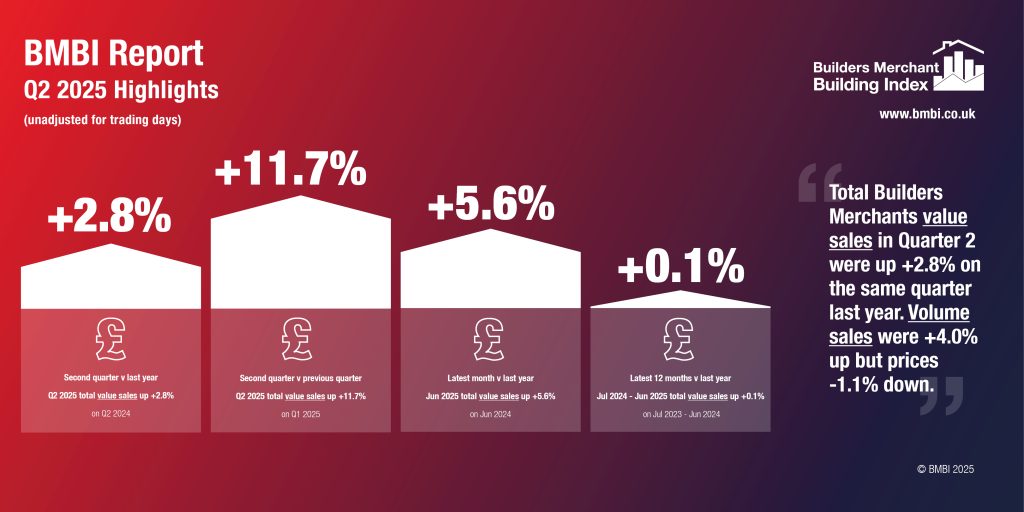The BMBI Experts’ Explainer Guide to UK Building Markets
BMBI Q2 2025: the story behind the numbers
The BMBI Q2 report is out giving us a much clearer picture of how 2025 is shaping up. Q2 delivered a second consecutive quarter of value growth and volumes are rebounding. Indexed on the year 2019 (100), Q1 (108.3) improved on a very weak Q4 2024 (103.0) and improved again in Q2 (120.9) the best quarter since Q3 2023 (122.9).

But this has been – and may continue to be – a difficult and uncertain year for construction and its supply chain. Here, the BMBI Experts share their views on the key talking points for Q2 and look ahead to what’s still to come in 2025.
Market performance
It has certainly been a year of mixed fortunes so far for the BMBI Experts and the market sectors they represent. In some markets, demand has fluctuated massively from month to month, often against the grain of established sales patterns. Like the standard disclaimer in selling finance, past performance is no guide to the future.
Jamie Barber, Dulux Trade: The trade paint market continues to improve with volume growth so far at +2% when compared to this time last year. Exterior categories like masonry have contributed to this growth and we see signs of strengthening in painter and decorator work pipelines, particularly for domestic repair, maintenance and improvement (RMI) work. There’s also been a return to purchases of premium aesthetic brands, helping to inject value into the market.
Chris Dawson, Brett Martin: We experienced a promising start to Quarter 2, coming on the back of some encouragement early in 2025, but around May a noticeable sense of concern could be experienced across the market as the anticipated seasonal spring construction uplift ran out of steam. Our daily order intake flattened at a time when we would normally see increases.
James Davenport, Metsa Wood UK: Spring saw some of the warmest, sunniest weather many of us can remember at this time of year, which supported strong demand for timber landscaping products, especially in the DIY sector. Demand for machined timber products, while showing signs of improvement at the beginning of the year, were subdued compared to landscaping products as people prioritised their outdoor spaces for improvement and renovation. After a reasonable start to 2025, demand for timber I-Joists and Kerto LVL eased in the second quarter as private housebuilding struggled to gain momentum. Timber I-joists are engineered beams with Kerto LVL (laminated veneer lumber) flanges, used to form a structurally efficient, lightweight, and strong building component for floors and roofs.
Krystal Williams, Pavestone: After a buoyant pre-sales season and a booming Q1, where our biggest challenge was getting stock to customers fast enough, Q2 continued in the same vein – until it didn’t. April and May saw Covid-lockdown levels of orders, with beige porcelain for example up 90% on last year, which we had not forecasted. But since June, the market has softened significantly.
Derrick McFarland, Keystone Steel Lintels: If 2025 is the first ‘normal’ year since 2020 then it is not great. While April was decent, May and June nullified any momentum that was building.
Andrew Simpson, Heidelberg Materials: After a better-than-expected start to the year, the robust sales seen in Q1 did not continue into Q2, and ready-mixed concrete volumes sank to a historic low. Aggregate sales were lower than expected across the board.
Ian Doherty, Hexstone (Owlett-Jaton): Demand in the fastener and fixings sector has continued to follow the general trends across merchants, with continuing soft demand driven by the sluggish levels of construction and Repair Maintenance & Improvement (RMI) activity.
Matt Williams, Polypipe Building Products: Recent trading updates from house builders and their supply chain partners confirm a flat market outlook. When markets are in this part of their cycle, there’s increased pressure on businesses to compete on volume while maintaining margins. This makes for a significantly more competitive commercial environment.
Emile van der Ryst, NiQ GfK: The second quarter of 2025 will likely be remembered for one word: tariffs. The announcement of Donald Trump’s wide-ranging tariffs on the 2nd April added yet another layer of uncertainty and complexity in what is turning out to be a very challenging decade across the world. Builders Merchants won’t be directly affected by tariffs as much, seeing that most products are sourced locally. It’s the impact on both the UK and global economy, and how this feeds through to the construction industry, that will be of most concern.
Labour pains
Government’s consistently vocal support for the construction industry and the lack of joined up thinking across government or follow through has been a hot topic for BMBI Experts since Labour swept to power with a pledge to build 1.5 million homes over the five-year parliament. While the Government has pulled levers to unblock growth in housebuilding and infrastructure, there has been little impact so far and this is causing frustration.
Derrick McFarland: There has been a notable slowdown in House Building in recent months despite our government being focused on delivering 300,000 homes a year. The focus on speeding up the planning process, the £39 billion for social and affordable homes, and removing the barriers for SME’s (Small to Medium sized Enterprises) are all potential initiatives to add some needed impetus into the market. The effective delivery of these actions is concerning however, and the path to growth is filled with potholes, not dissimilar to our current road network.
Chris Dawson: Construction relies on so many of the factors which government controls or influences, with business and consumer confidence being the vital spark which provides momentum. Both are lacking currently, and the effects play out directly in key RMI (Repair Maintenance & Improvement) project spending in businesses and homes across the country. We are confident that this market will find its way back to growth, despite the apparent shortcomings of the current administration’s policy.
Andrew Simpson: For all its rhetoric about generating growth in and through the construction industry, real tangible government support for our sector is yet to materialise and it’s hard to see things improving before the end of the year.
Mike Rigby, MRA Research: Now would be a very good time for the Chancellor and Prime Minister to make good on their promises to clear the obstacles to build 1.5 million homes by the end of this parliament and get Britain building and the economy growing.
Restoring confidence
Some BMBI Experts highlighted the need to restore confidence – in consumers, businesses and investors – to get the wheels of progress turning for the good of the economy, the construction industry and for builders’ merchants and continue the growth mentality into Q3.
John Newcomb, BMF: As Bill Clinton famously understood in winning the US presidential election in 1992, the key to success is confidence in the economy. When consumers and businesses feel optimistic about the economy, they are more likely to spend and invest, fuelling growth and job creation. The current climate of uncertainty is constraining the conditions required for sustained growth.
Jamie Barber: Should consumer spending falter in the run up to the Autumn budget, as it may do given consumers’ weakening confidence in the face of gloomy economic news and warnings of potential tax rises, then we’re likely to see higher savings rates, as those who can save prepare themselves to ride out the risks of increased costs and greater uncertainty. If that happens, our positive outlook [for the year] could turn south. But consumer confidence marches to its own drum and it’s often more resilient and capricious than observers expect.
The BMBI Experts’ forecast?
Krystal Williams: 2025 has given us some incredible highs and some hard times that we hadn’t expected. With the forecasts out the window, who knows what H2 2025 holds for the paving sector, and our landscapers and merchants. Whatever happens, we must face it together with mutual understanding and patience.
John Newcomb: Many of us had high hopes that 2025 would signal the beginning of a significant recovery for the construction industry and building materials sector. Our optimism did not account for the ongoing impact of economic uncertainty, which continues to dampen confidence and hold back growth. The latest figures for Q2 2025 – our own included – show some year-on-year growth, albeit from a low base, but are less certain on future work.
Andrew Simpson: Most predictions for 2025 were betting on a H2 recovery but the current aggregate sales tell a different story. Less concrete sales in H1 mean fewer concrete slabs to build on in H2, suggesting the foundations have not been laid for recovery in the second half.
Emile van der Ryst: The rest of the year brings uncertainty. While there has been cautious optimism around the sector, the reality and impact of economic pressures could erode expected growth for the remainder of 2025.
Chris Dawson: The statistics don’t lie, 2025 has not seen any significant growth in housing starts resulting in what looks like a very flat UK house construction market this season.
James Davenport: Global trade and uncertainty around the imposition of tariffs by the US administration on major timber exporting countries casts a long shadow. The impacts on global trade flows and prices could be significant.
Jamie Barber: Our outlook for the second six months of the year expects the market to remain in growth territory, especially as housing transactions earlier in the year, brought forward to beat changes to stamp duty, are likely to contribute to more painting and decorating jobs being undertaken in the coming months.
Derrick McFarland: Between the ‘slow’ government initiatives and the geopolitical landscape, 2025 will continue to be challenging in construction.
Gordon Parnell: Off the back of more stable interest rates, the construction sector is starting to see greater stability. This has contributed towards greater optimism for the longer term which is expected to remain into the second half of the year, with sector growth on the horizon: 2025 is not as buoyant as hoped, but green shoots remain.
Head over to bmbi.co.uk to read the experts’ full comments.
